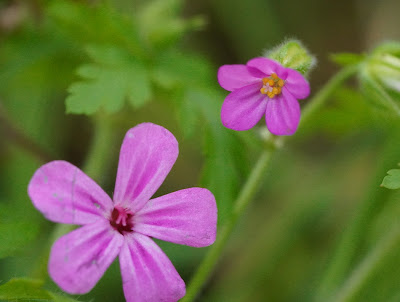There are a number of different Crane's bill (Geraniums) species on the courses at the moment. These are so-named because of their elongated fruit's which supposedly resemble a crane's beak. The most common by far is Dove's-foot Crane's-bill which is all over all three courses on most holes.
 |
| Dove's foot Crane's-bill Geranium molle [Doghouse range] |
A week or so ago I found Dusky Crane's-bill by the 1st tee Blue. I haven't been able to find it since, so I suspect that a deer may have eaten it.
 |
| Dusky Crane's Bill Geranium phoeum [1st Blue] |
On the Doghouse range I found Hedgerow Crane's-bill earlier this week:
 |
| Hedgerow Crane's-bill Geranium pyrenaicum [Doghouse range] |
Another very common Crane's-bill is Herb Robert - a plant I know particularly well as I pull it up in large quantities from my drive and patio every weekend. This plant is on the path between the driving range and the 16th Blue.
 |
| Herb Robert Geranium robertianum [Tubney driving range] |
I was convinced that I had found another species of Geranium known as Little Robin or Lesser Herb Robert. This plant is very similar to Herb Robert, but has much smaller flowers and yellow anthers (part of the middle of the flower) and is also incredibly rare. I compared it to Herb Robert growing nearby and as you can see in the photo, my flower (top right) is considerably smaller than Herb Robert (bottom left) and appears to have yellow anthers.
In my excitement I sent a ton of photos to Susan and Frances - two experts from the Ashmoleum Natural History Society of Oxford, who looked at these and told me that my flower was likely to just be a small Herb Robert. Undeterred, I invited them along to look at the plant, which they very kindly agreed to do and they very quickly confirmed.... that it was just a small Herb Robert. Whilst the anthers appear to be yellow, this is actually the pollen and closer inspection confirmed that, where no pollen is present, they are orange, which confirms an identification of Herb Robert. They were very good about it and offered consolation that they could see how I reached my erroneous conclusion. Fortunately the plants are very near the car park so at least I didn't drag them on a long walk in the rain to see a plant that grows on everyone's drive. It was a useful learning experience, the main lessons being:
1. That there is more to identifying plants than looking at pictures and seeing which looks most similar;
2. That there is considerable variation in plant morphology within the same species; and
3. When you hear hooves, think horse not zebra.

No comments:
Post a Comment